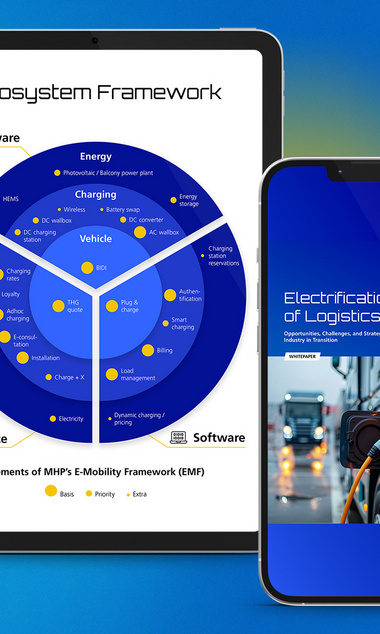
- Success Story
A product oriented IT approach: future-proof mobility
MHP & BVG
Berliner Verkehrsbetriebe is creating agile frameworks within its CIO division so it can efficiently execute customer-centric projects for the mobility transformation.
Public transportation is an essential way of getting around, especially in a major metropolis like Berlin. It stimulates the economy, boosts local companies and businesses, and creates jobs.
To this end, Berliner Verkehrsbetriebe (BVG), Germany’s largest municipal transport company, runs subways, trams, buses and ferries, and currently employs more than 15,800 people.

BVG driving forward the mobility transformation
A capital’s major artery, like BVG’s network, is under constant pressure to change and evolve. On the one hand, this includes the topics of digitalization and speed, which every company needs to face if they want to be fit for the future. On the other hand, BVG is eager to take another big step (or several) and serve as a key driver of the mobility transformation: a modern, climate-neutral mobility services provider who actively shapes the future by intelligently networking a range of different mobility offerings, instead of just following the herd.
The CIO division was reshaped and optimized as part of the “VI4Future” project to enable IT to take on shaping this change.
Agile management mindset softens rigid organizational structures
The information technology and sales technology fields play a key role in overcoming the challenges posed by the mobility transformation. As a strategic partner, innovator and architect, IT is crucial for the joint development of new business models. In turn, it lays the business foundations for the mobility transformation in other specialist areas.
The departments in this area were confronted with ever more complex interactions and heightened expectations in terms of speed, quality and user-friendliness. Teams were too disparate, from an organizational perspective, both within the IT department and within BVG as a whole: there was a lack of mutual transparency. The plan-build-run structure was fully moved over to an agile product organization, in alignment with the updated role of the CIO organization and its new understanding of itself. It was necessary to generate knowledge of an agile management mindset and the corresponding ways of working so that BVG’s ambitious goals could be made a reality.

Cultural and structural change for measurable success
In other words, it was imperative to rethink things from the bottom up and put new strategies and measures into practice – which BVG achieved in collaboration with MHP.
The new product-based organizational structure meant that 40 teams had to reform, while individual strengths and skills also needed to be compiled for the sake of product improvement. The convergence of different cultures played a role, too.
Coaching teams consisting of internal BVG employees were given didactic tools to disseminate knowledge in an appealing, targeted manner.
With MHP’s support, 60 percent of the teams drew up quarterly roadmaps that helped them better align with internal customers and increased transparency by a wide margin.

In the wake of the new strategy, crucial cross-team quarterly plans (PI plans) were created to identify dependencies and synergies among the teams. This required active discussion. In turn, rigid, outdated structures had to give way so the framework for these changes could be created.
Susanne Schuldt, Head of IT Strategy and Portfolio Management, and sponsor of the agile transformation, welcomes this customer-centricity: “Our CIO organization is now closer to our customers than it’s ever been before, as evidenced in the high level of satisfaction among the specialist departments. In collaboration with MHP, we were able to develop a holistic approach to transformation. This iterative, participatory process safeguarded transparency and ensured our employees were involved at every turn. We have sustainably embedded shared values like openness and courage within our company, alongside agile collaborative methods.”
Higher sense of responsibility leaves employees and customers more satisfied
During the transformation program, employees were given a large amount of independent responsibility via measures that empowered them to think and act innovatively. This improved the overarching climate in the workplace: an internal survey showed that 83 percent of colleagues in the CIO division were satisfied with their tasks and activities. Today, this transformation project serves as a role model for other divisions at BVG that need to lay the foundations required for the necessary digital shift.
The positive change triggered by these measures has also impressed CIO Dr. Henry Widera: “All told, we saw substantial growth in successfully executed processes (>10 percent) and a significant acceleration in the speed of processing incidents (+20 percent) and requests (+50 percent), for instance.”

Cross-sector skills and holistic approaches for a successful future
MHP proved itself to be a reliable partner during this structural change thanks to its years of experience in the sector and its holistic approach to consulting. This came to bear in strategy development, but also in the operationalization and sustainable embedding of bespoke competence concepts, which ran in parallel and were designed to function regardless of the level of maturity. It was this expertise and skill, and the speed with which a trusting relationship developed, that enabled productive collaboration to occur at every level of the hierarchy. CIO Dr. Henry Widera confirms just how successful this was: “The transformation program laid the foundations for the outstanding performance that the CIO division is seeing at present. In conjunction with MHP, we have successfully launched our strategic realignment and introduced an agile product organization for over 400 of our colleagues. We were fully convinced by MHP’s expertise, right from initial contact through to project sign-off.”

Agile methods create new structures and knowledge transfer
It’s not only BVG who can benefit from taking such steps. Every major company with a portfolio of products and services can reap the rewards. This goes for every organization that wants to improve their ability to adapt to changing economic frameworks while also making their collaboration more efficient. However, introducing agile methods, the right mindset, management of change and an open culture of learning and error tolerance can especially add a real competitive edge for companies and conglomerates looking to use enhanced transparency to optimize their customer experience and improve collaboration.
"In conjunction with MHP, we have successfully launched our strategic realignment and introduced an agile product organization for over 400 of our colleagues. We were fully convinced by MHP’s expertise, right from initial contact through to project sign-off."
"Our CIO organization is now closer to our customers than it’s ever been before, as evidenced in the high level of satisfaction among the specialist departments. In collaboration with MHP, we were able to develop a holistic approach to transformation."




